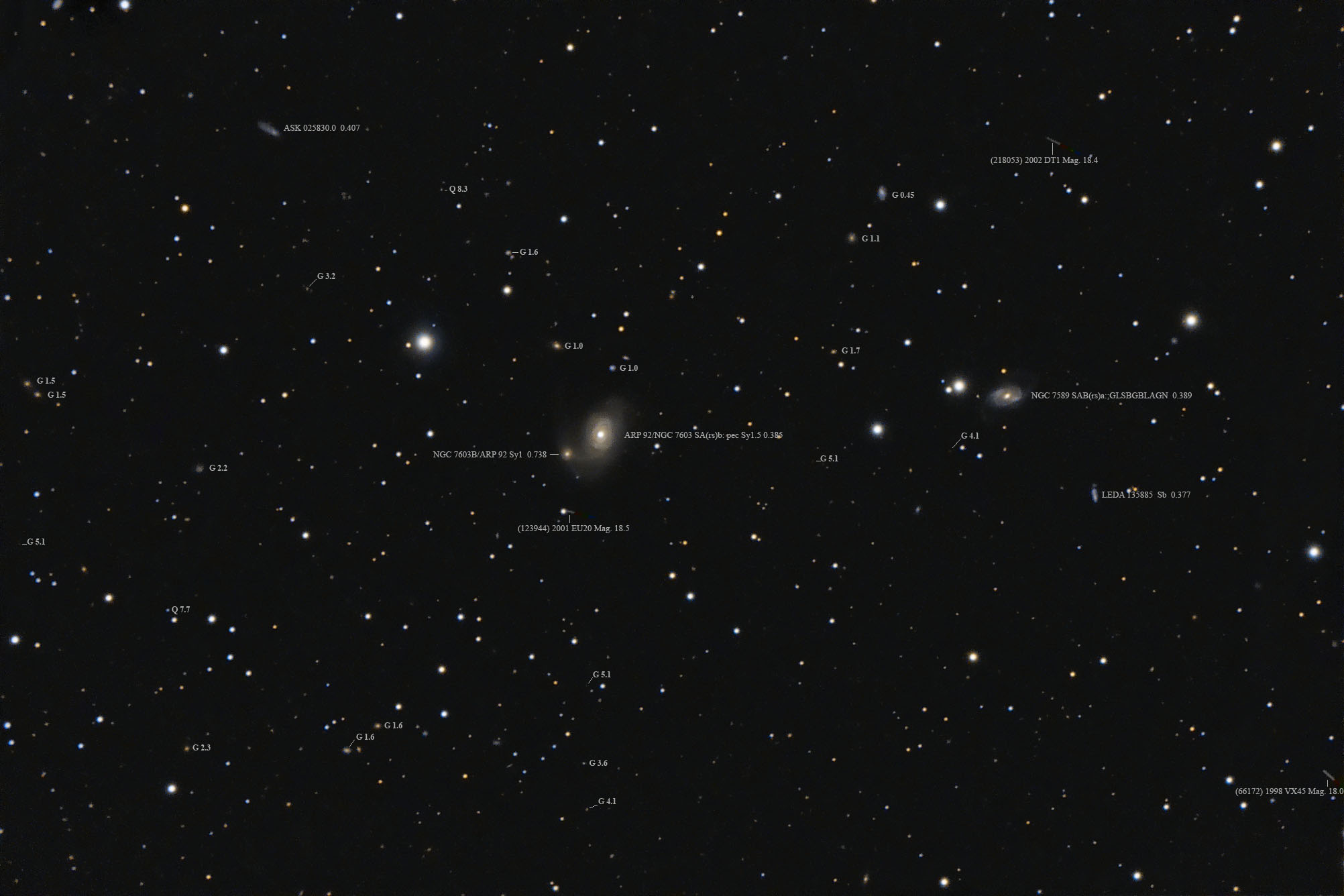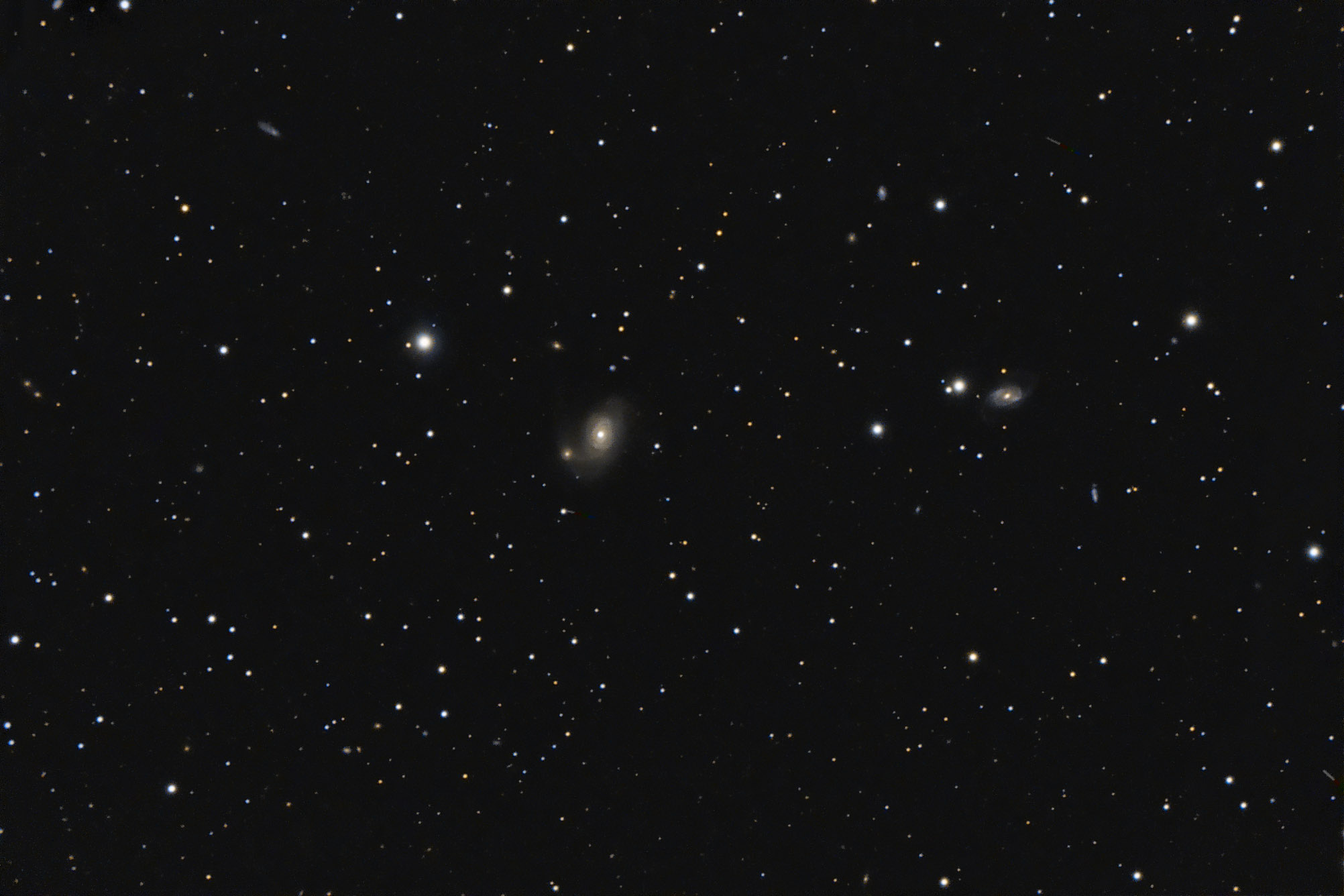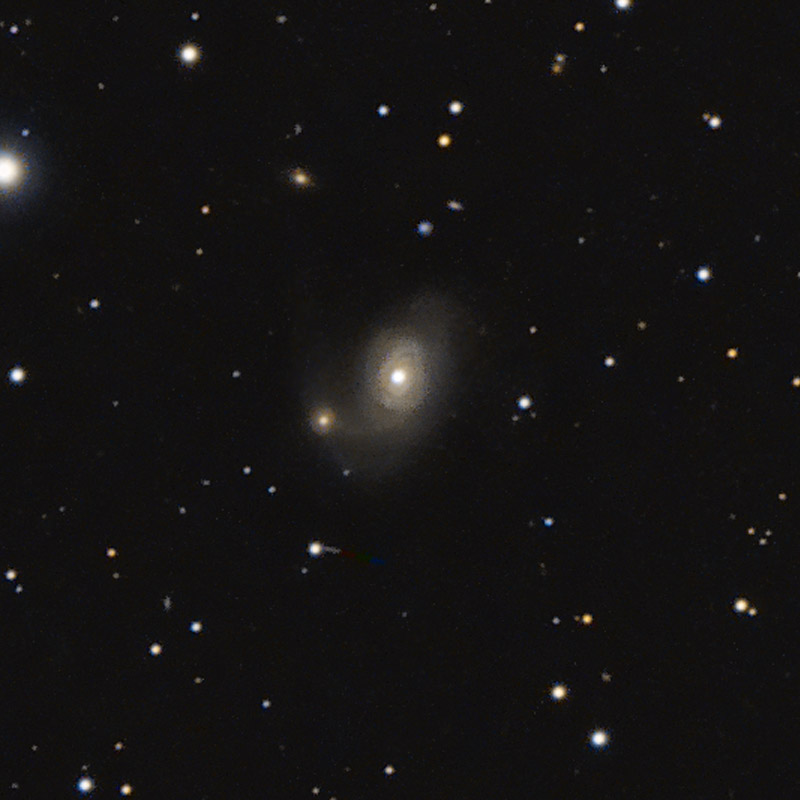Object name: ARP092Designation(s): ARP092, NGC7589, Arp 92 falls under Arp's class: Spiral galaxies with companions on arms: Elliptical galaxy companions. If by "companion" Arp includes unrelated line of sight galaxies then this might be true. In this case red shift data, possibly not known when Arp prepared his catalog, shows the main galaxy, NGC 7603 has a light travel time distance of 385 million light years while the "companion", NGC 7603B is at a distance of 728 million light years, nearly twice as far away. So it isn't the cause of the distortion and tidal plume coming from NGC 7603. Or is it, NED lists a couple papers that do consider it a true companion even acknowledging the red shift difference. Arp comments: "Very faint connection shows better in red." Indicating he sees this plume as a true linkage. In later years Arp denied red shift necessarily indicated distance though at the time of the catalog he hadn't come to this belief. It is classed as SA(rs)b: pec and is a Seyfert galaxy. So is it a companion or not? I'll say no until better evidence is provided. NGC 7603 was discovered by Albert Marth on October 23, 1864.
With time the "guilty" galaxy might be some distance away. There are two candidates I find in the image. NGC 7589 to the west (right) is the odd spiral with faint narrow arms. It has a redshift almost identical to that of NGC 7603 that puts it at 389 million light years. It is classed as SAB(rs)a: and is a Seyfert 1 galaxy. So it is the most likely candidate for the true "companion". Though in the upper left corner is another possible mugger. It is odd rather "sloshed" streak of a galaxy known as ASK 025830.0/SDSS J231929.76+002212.0 at a redshift that puts it a bit further away at 407 million light years. Sometimes an interaction will move the core of a galaxy from the center and toward the galaxy it interacted with. Could that explain this galaxy? All this is speculation on my part. Too bad we can't rewind time and see what this system looked like a billion years ago. To me, a more likely cause is a merger. The plumes caused by a merger in the past.
Adding to the confusion is that the galaxy Arp considered the companion, NGC 7603B is also a Seyfert 1 galaxy. Probably just a coincidence. Some galaxies just have an active core. That could be the case here.
There happened to be three asteroids in this image. The one below Arp 92 is (123944) 2001 EU20 at an estimated 18.5 magnitude. The one to the northwest corner is (218053) 2002 DT1 at an estimated 18.4 magnitude. Yet it is obviously dimmer in my image. Though this may be an illusion due to its more rapid motion. The third is in the lower right corner and is (66172) 1998 VX45 at an estimated magnitude of 18.0.
West of Arp 92 beyond and a bit below NGC 7589 is an odd, apparently double, very blue, galaxy. As I've mentioned many times before these are often excluded from the SDSS catalog as listed in NED. This is another example. It was picked up by the automatic plate survey so is listed under it as APMUKS(BJ) B231533.01-000313.1 It also made LEDA as LEDA 135885 but not Sloan. But NED makes the odd classification as Sb or plate flaw! Then to make this more ridiculous they calculate a redshift distance of 377 million light years for this possible plate flaw. It is yet another strange galaxy that is part of the group with Arp 92. So is it a double galaxy or one with a plume or what is it? Is it involved with Arp 92? Note that in my image the upper half is a bit bluer than the lower half. Also, NED classified it as either Sb or a plate defect. Apparently, some things don't change when new information is available. You can't get a distance estimate from a plate defect by any means I'm aware of. Things just get curiouser and curiouser as Alice would say.
There are quite a few galaxies right at the limit of this image. They are about 22nd magnitude and about 5.1 billion light-years away. At least a few are of this same distance. I've prepared an annotated image with galaxy and quasar distances labeled in billions of light years. As usual, the label is just right of the object unless this isn't possible without hiding something. You may need to enlarge the image to see some of these little faint guys. My limiting magnitude here was about 22.4 in green light. NED lists some 5000 galaxies in this image with a redshift value. The annotated image only shows a few that interested me.
Arp's image
http://ned.ipac.caltech.edu/level5/Arp/Figures/big_arp92.jpeg
14" LX200R @ f/10, L=4x10', RGB=2x10'x3, STL-11000XM, Paramount ME Related Designation(s):1RXP J231856.6+001448, 1RXS J231856.8+001436, 1WGA J2318.9+0014, 1XMM J231815.6+001539, 1XMM J231856.6+001438, 2MASS J23181568+0015403, 2MASS J23185665+0014378, 2MASX J23181570+0015403, 2MASX J23185663+0014376, 2PBC J2318.9+0014, 2XMM J231815.6+001540, 2XMM J231856.6+001437, 2XMMp J231815.6+001540, 2XMMp J231856.6+001437, AGC 630165, APMUKS(BJ) B231541.93-000044.3, APMUKS(BJ) B231622.86-000145.9, ARP 092, ARP092, ASK 025577.0, CGCG 2315.8+0000, CGCG 2316.4-0001, CGCG 380-024, CGCG 380-026, GALEXASC J231856.60+001437.6 , GALEXMSC J231856.67+001436.9 , GASS 01977, IRAS 23163-0001, IRAS F23163-0001, LAMOST J231856.66+001438.0, LDCE 1571 NED003, LQAC 349+000 061, LQAC 349+000 068, MCG +00-59-019, MCG +00-59-021, MRK 0530, NGC 7589, NGC 7603, NGC7589, NPM1G -00.0622, NSA 005429, NSA 151098, NVSS J231856+001437, PBC J2318.9+0014, PGC 070995, PGC 071035, RBS 1982, RX J2318.9+0014, RX J2318.9+0014:[BEV98] 002, RX J2318.9+0014:[ZEH2003] 01 , SDSS J231815.66+001540.1, SDSS J231815.66+001540.2, SDSS J231815.67+001540.2, SDSS J231856.65+001437.9, SSTSL2 J231815.69+001540.1, SSTSL2 J231856.60+001438.4, SWIFT J2318.9+0013, SWIFT J2319.0+0014, UGC 12493, UM 156, UVQS J231856.66+001438.0, UZC J231815.7+001540, UZC J231856.6+001437, [DBW2004] J231856+001437, [dML87] 736, [GVI2006] LSB 473, [HBW2011] J231815.67+001540.2 , [HBW2011] J231856.65+001437.9 , [ISI96] 2315-0000, [MHH96] J231856+001436, [SLW2012] 110, [SRD2016] 05, [SUV2010] 201, [VCV2001] J231856.7+001438, [VCV2006] J231815.6+001540, [VCV2006] J231856.7+001438, | | 

